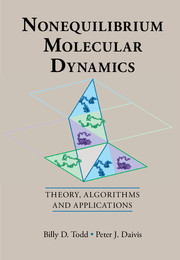Book contents
- Frontmatter
- Contents
- Preface
- 1 Introduction
- 2 Nonequilibrium Thermodynamics and Continuum Mechanics
- 3 Statistical Mechanical Foundations
- 4 Temperature and Thermodynamic Fluxes
- 5 Homogeneous Flows for Atomic Fluids: Theory
- 6 Homogeneous Flows for Atomic Fluids: Applications
- 7 Homogeneous Heat and Mass Transport
- 8 Homogeneous Flows for Molecular Fluids
- 9 Inhomogeneous Flows for Atomic Fluids
- 10 Confined Molecular Fluids
- 11 Generalised Hydrodynamics and Slip
- Bibliography
- Index
8 - Homogeneous Flows for Molecular Fluids
Published online by Cambridge University Press: 30 March 2017
- Frontmatter
- Contents
- Preface
- 1 Introduction
- 2 Nonequilibrium Thermodynamics and Continuum Mechanics
- 3 Statistical Mechanical Foundations
- 4 Temperature and Thermodynamic Fluxes
- 5 Homogeneous Flows for Atomic Fluids: Theory
- 6 Homogeneous Flows for Atomic Fluids: Applications
- 7 Homogeneous Heat and Mass Transport
- 8 Homogeneous Flows for Molecular Fluids
- 9 Inhomogeneous Flows for Atomic Fluids
- 10 Confined Molecular Fluids
- 11 Generalised Hydrodynamics and Slip
- Bibliography
- Index
Summary
Explicit and Coarse-grained Molecular Models
The first NEMD simulations of molecular fluids were mostly performed with coarsegrained or simplified molecular models because simulations of more realistic, explicit models had high computational demands compared to the computing power then available. For simpler molecules, such as diatomic nitrogen and chlorine, nonequilibrium simulations of explicit molecular models were performed very early, but for more complicated molecules such as the n-alkanes, many of the earliest NEMD simulations were done with models that employed approximations such as the united atom approximation, where CH2 and CH3 groups were modelled as identical interaction sites with simplified intermolecular potentials. Furthermore, it was usually assumed that all bond lengths and bond angles were rigidly constrained and that dihedral angle potentials followed simplified functional forms. With the rapid growth in computational power, many of these assumptions have become unnecessary, but there are often good physical reasons for assuming that bond lengths should be constrained in classical molecular dynamics simulations. Therefore, constrained molecular models remain an important and useful part of the simulation toolkit, and we will devote some time to them in this chapter.
Many early attempts at coarse-graining were ad hoc and expedient, with little theoretical justification. This has recently changed quite dramatically, and the statisticalmechanical theory of coarse-graining and multiscale simulation is now an active field of research [266–268]. Here, we will only very briefly introduce a few simple coarsegrained models that are of interest mainly because they appear so prominently in the literature and they are so useful for simulating the general qualitative features of the dynamics of molecular fluids with minimal computational demands.
All-atom and United Atom Molecular Models
Explicit, all-atom molecular models and potential energy functions (force fields) are now available frommany different sources, such as the enormous literature on molecular dynamics packages for biomolecular simulations and computational materials science. Generally speaking, most users of these potential energy functions encounter them in packages, which are already well-documented and do not need to be discussed here.
- Type
- Chapter
- Information
- Nonequilibrium Molecular DynamicsTheory, Algorithms and Applications, pp. 229 - 265Publisher: Cambridge University PressPrint publication year: 2017



